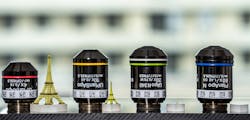3D laser printer by UpNano produces polymer parts over 12 orders of magnitude in volume
A high-power laser, optimized optical pathway, a patented adaptive resolution technology with multiple objective lenses and smart algorithms for laser scanning allow high-resolution 3D-printing at volumes ranging from 100 to 1012 cubic micrometers. Parts with nano- and microscale resolution can now be printed across twelve orders of magnitude in times shorter than previously possible.
This has been accomplished by UpNano (Vienna, Austria), a spin-out of TU Wien, which developed a high-end two-photon-polymerization (2PP) 3D-printing system that allows for a nano- and microscale resolution. Recently, the company demonstrated this capability by printing four models of the Eiffel Tower ranging from 4 centimeters to 200 micrometers, with perfect representation of all minuscule structures, within times of 30 to 540 minutes.
2PP 3D printing is an ultraprecise production technology that so far could only be optimized for a very limited range of scales. Also, production in the centimeter range (the "meso-range") took an extremely long time and was thus unattractive for quantitative production in industry.
"Together with an optimized optical path and smart algorithms, we can utilize the full laser power up to 1 W, which is several times more than in comparable systems," says Peter Gruber, head of technology and cofounder of UpNano. Such a powerful laser delivers enough energy for high-speed printing, especially in the adaptive resolution mode. This is a significant advantage compared to other systems that use lower-power lasers and are therefore limited in throughput.
Printing in the difficult meso-range
"The benefit of this innovation is most notable in the meso-range," adds Bernhard Küenburg, CEO of UpNano. "The NanoOne system offers significantly faster production times than other systems. Add our patented adaptive resolution technology to this, and you end up with a capability to print centimeter-large objects with a micrometer resolution in short production cycles.” The algorithm allows widening of the laser spot up to a factor of 10 in accordance with the specifications of the printed specimen.
A simple change of objectives (there are different ones available, ranging from 4X magnification to 100X) allows the production of parts in the micro-range with resolutions at the nanometer scale. This, too, is much faster than other systems thanks to the specific optical pathways, the optimized scan algorithms, and the proprietary adaptive resolution technology, according to UpNano.
The system has been met with great interest in R&D and in industry right after its introduction, says UpNano. An example of its use in medicine and research is the production of microneedles with tight tolerances and defined features such as sharp tips, cannulas, or reservoirs.
Functional micromechanical parts are another interesting area of application for the UpNano technology. A benchmarking example is a functional spring with a height of 6 mm printed in less than 6 minutes, or two-component parts with included moveable elements printed in single printing jobs for med-tech applications.
Filters are another example: Sizes of several square centimeters with pore sizes in the low-single-digit micrometer range can be printed within hours. "Such filters have exactly defined pore sizes for 100 percent of all pores," says Küenburg.
Source: UpNano
About the Author
John Wallace
Senior Technical Editor (1998-2022)
John Wallace was with Laser Focus World for nearly 25 years, retiring in late June 2022. He obtained a bachelor's degree in mechanical engineering and physics at Rutgers University and a master's in optical engineering at the University of Rochester. Before becoming an editor, John worked as an engineer at RCA, Exxon, Eastman Kodak, and GCA Corporation.

